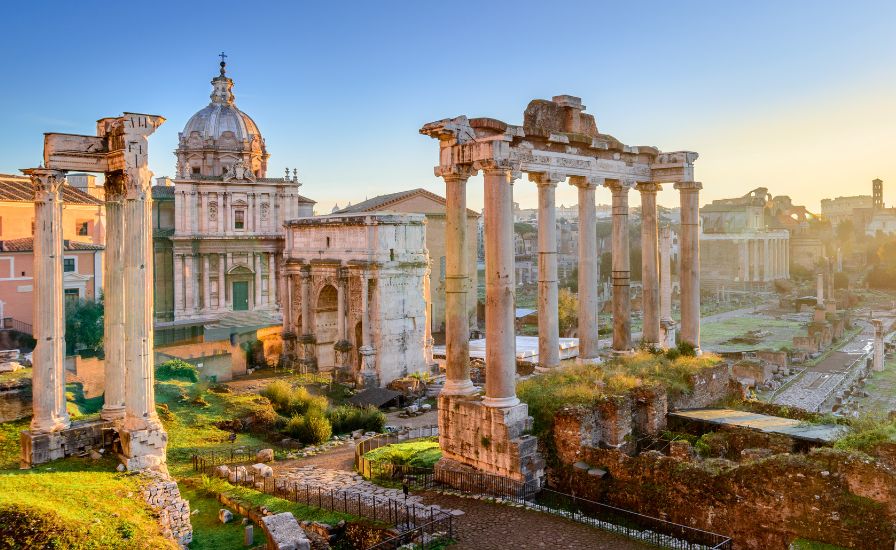4. Palazzo Colonna
Though frequently disregarded, a visit to this magnificent building during Rome sightseeing which is home to one of the most powerful families in Rome is well worthwhile. Due to its production of cardinals, Pope Martin V, and other political and royal personalities, Palazzo Colonna is a significant part of Roman history.
There are rumors that Dante Alighieri, the renowned poet from Italy, visited this place. The poetess Vittoria Colonna's close friend Michelangelo also paid them many visits.
Constructed over five centuries with the assistance of architects like Rainaldi and Marucelli, the Colonna Gallery, one of Rome's most important private art collections, is unquestionably the building's most notable feature. It houses artwork by Italian masters like Ghirlandaio, Bronzino, Tintoretto, and Carracci, as well as ceiling frescoes by Gherardi and Chiari, among others.
However, the rooms, hallways, and gardens will all be just as intriguing. It is still the official residence of the Colonna family even though it is available to the public.
5. Roman Forum

Even though the forum is now in the middle of a bustling modern metropolis, it feels like you are walking through the heart of ancient Rome two millennia ago. The standing and fallen columns, the triumphal arches, and the remnants of its walls still make an impression, even though what's left of this hub of Roman governance and life only represents a small portion of its original splendor.
This is especially true when you consider that, for centuries, the history of the Forum was the history of the Roman Empire and the Western world. Along with the courts, marketplaces, and gathering spots, this was the hub of Roman political and religious life. Churches and castles emerged amidst the ancient ruins after the structures fell into ruin around the seventh century.
Its stones were mined for use in other construction projects, and careful digs did not uncover the ancient structures behind a ten-meter layer of debris and earth until the 18th and 19th centuries. We recommend you take a Roman self-guided tour for a better experience and to visit the Roman Forum, go for a Colosseum, Roman Forum & Palatine Hill Audio Tour to learn things on your own.
6. Piazza Navona
One of the most magnificent squares and wonderful places to visit during Rome sightseeing is Piazza Navona. Therefore, the famed square's elongated design might be attributed to its original use as a Roman athletics stadium. Several fountains, including Bernini's "La Fontana dei Quattro Fiumi," an intriguing obelisk, and the excavations of the former Domitianus stadium are among the square's noteworthy features. Piazza Navona is also a bustling square with lots of cafés, terraces, and street performers.
Constructed atop the Stadio di Domiziano in the first century, it underwent pavement in the fifteenth century and served as the primary marketplace for the city for nearly three centuries. Come early in the morning before the people gather or after dark when the fountains are illuminated to experience the piazza at its most charming. The drinking fountain known as the "big nose" or nasone is located north of the plaza. Fill up with water there.
Upon entering, start your tour on your own by choosing the Piazza Navona self-guided audio tour and discover all the main sights as you move forward with your visit.
7. Musei Vaticani and Cappella Sistina

What would you say to the Pope if you met him? You can join an audience with him on Wednesday mornings, though it's unlikely that you will. This general audience is held in the audience hall of Sala Nervi if the weather permits, but it also happens in St Peter's Square. Be prepared to mingle with masses of tourists holding cameras and pockets of devoted Catholics. After that, you get the chance to explore St. Peter's Basilica, take in the breathtaking frescoes by Michelangelo in the Sistine Chapel, and see the renowned "Belvedere Apollo" and "Laocoön" at the Vatican Museums' Museo Pio-Clementino.
8. Capuchin Crypt
This site is not for the faint-hearted. Located beneath the church of Maria della Concezione dei Cappuccini, the Capuchin Crypt is composed of several underground chapels. Inside, you will find tombs that hold the remains of around 3,700 monks who died between 1500 and 1870. Bones, skulls, and the complete skeleton are hanging on the walls like artwork.
These exhibits are not supposed to be frightening. Rather, they serve as a reminder that our time here on Earth is fleeting. And maybe, if not beauty, significance can still be found in death.
Final Words
So, this was the whole list for you to see while taking the Rome city tour. Of course, there is so much more to see and do in Rome than we mentioned here. But if you want to experience the eternal Rome city, this list will surely help you to guide what to see first.
Have a wonderful journey and don’t forget to take a Rome self guided tour to have a better travel experience.









